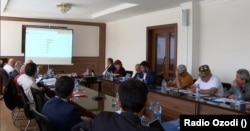DUSHANBE -- A new public opinion poll suggests that long-popular Russian television channels have seen a growing decline in their viewership in Tajikistan in the past three years.
Tajiks are instead watching more Persian- and Uzbek-language television, the survey shows.
But Russian news channels continue to have a major impact on public opinion in the former Soviet country, according to research conducted by local pollsters Mashvarati Rasonai (Media Advice) and Zerkalo (Mirror).
The survey -- funded by the U.S. Embassy in Tajikistan -- spoke to 2,500 people across the country of about 9.9 million and asked them which foreign television channels they have watched since 2019.
“For the first time, the Rossia TV network dropped to third place, while the channel NTV fell to fifth place,” the survey concluded.
State-owned Rossia and NTV, which is funded by Gazprom Media, boasted the highest viewership in Tajikistan for many years.
The drop in their popularity is linked to the growing “decline in the use of the Russian language among the younger generation” in Tajikistan, said Nabi Yusupov, the head of the polling group Mashvarati Rasonai.
But the researchers said Russian news channels continue to play a major role in shaping public opinion in Tajikistan.
“The influence of the Russian media remains intact in Tajikistan. We can see that in their everyday lives, people frequently discuss and quote the information they get from the Russian media,” said Qahramon Baqozoda, chief of Zerkalo.
GEM TV, a Turkey-based Iranian group of entertainment satellite channels, was named the most-popular television station by respondents. GEM TV's soap operas attract massive amounts of viewers in Tajikistan.
Respondents added that they watch entertainment programs aired from neighboring Uzbekistan by channels like Yoshlar, Zur TV, and Uzbekiston.
The survey also found that private Afghan TV channel Tolo has significantly dropped in the ratings in Tajikistan since the Taliban came to power in Afghanistan in August. Asked why, those surveyed said the channel now has more programs in the Pashto language, which they don’t understand.
The survey concluded that Tajikistan’s domestic television channels “should compare their own programs with the content of the most-popular foreign channels” and try to “produce content that meets the requirements of the local audience.”
There are 15 state channels and 18 private televisions in Tajikistan. The state channels that get abundant funding and political backing from the government are easily accessible in most parts of the country.
Among domestic channels, state-owned Televizioni Tojikiston and Safina have the highest viewership, the survey found.
Critics say state channels are mostly engaged in promoting government propaganda and avoid any coverage of politically sensitive topics. Officials deny such criticism.
The survey showed that television remains a major source of news for many Tajiks, although use of the Internet has been on the rise, too.
The decline of print media outlets deepened during the COVID-19 pandemic when several newspapers, including the popular Charkhi Gardun and Digest Press, went bankrupt.
Nearly 70 percent of the respondents said they don’t read newspapers. Asked why, nearly 30 percent said they rely on the Internet for daily news.
Two percent of the respondents said they regularly read the website of RFE/RL’s Tajik Service, while 1.2 percent said they read Tajik independent news website Asia Plus.
However, the survey said that in addition to their websites, the Tajik Service and Asia Plus have also garnered a substantial following on social media, including YouTube, Facebook, and Instagram.
Authoritarian Tajikistan has long been criticized by media advocates and international rights watchdogs for restricting press freedom and free speech.















